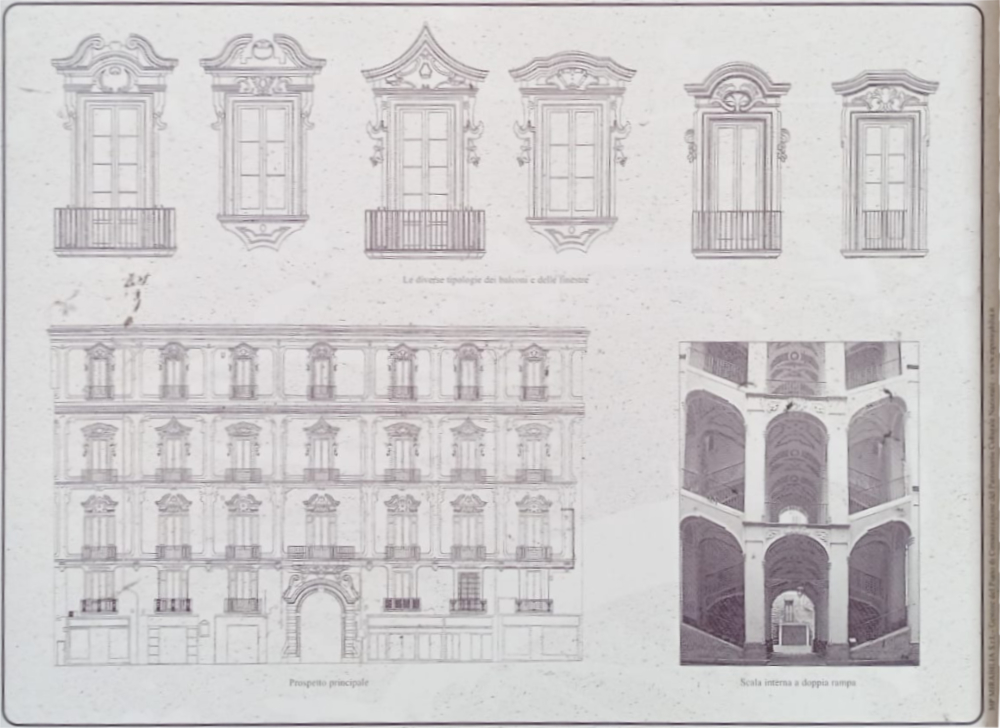Hawk-winged staircase
A hawk-winged staircase refers to and open staircase and double flight of stairs, best associated with the Spanish Palaso in Naples. The Spanish Palaso was declared a national monument in 1925 because of its considerable historic artistic importance, confirmed in 1939.
In the 1600s Baron don Aniello D'Orso of Abanella owned two adjacent palaces in the Vergini quarter and when he died his assets passed on first to his son, don Fabrizio, who died at an early age and then to his voungest sister; Anna Maria, who married Marquis Nicola Moscati of Poppano, from ay noble family of intellechals that had wade their fortune trading cattle and horses.
In 1738, Nicola Moscati stipulated a works contract with Francesco Attanasio, engineer and "draughtsman" of the Sacred Royal Council, to build a single establishment in place of the nwo pre-existing buildings. During the works, that cost 29,987 ducats, Attanasio relied on the collaboration of the master builder Felice Polito.
In fact, the building's construction has always been attributed to Ferdinando Sanfelice, but the name of the famous architect never appears in any of the notary deeds. However it cannot be ruled out that, while working on the construction of his own palazzo, a few metres away, Sanfelice had given out some "advice", especially on the construction of the elegant staircase with an open double flight of stairs, known as "hawk-winged staircase".
Nicola Moscati thus had his magnificent palazzo which, because of its architectonic beaury and the splendour of its furniture and fittings, was considered one of the most beautiful and famous in.
Naples. For instance, the lunettes and the ornamental panels (over the doors) on the various, Moors, decorated in stucco with busts framed by volutes and typical Baroque floral elements and the stuccoes designed by Giuseppe Astarita, perfectly in keeping with the Neapolitan Rococo style.
Over time, the palazzo had several owners because of debts incurred. In fact. the Moscati were forced to cede it to the Mastrilli, Marquis of Livardi and in 1813 is was almost entirely bought by the Spanish nobleman, don Tommaso Atienza and his wife Anna Maria Pelliccia, after whose nationality the building was named "Spanish".
Atienza, who was the Attorney General and agent of don Vincenzo Ossorio of Madrid, as well as the attorney for the convent of the Discalced Nuns of St. Francis, commissioned the architect, Antonio Pecovaro, to do the extension work of the right side of the building, and the painter Domenico Pane to decorate the ceilings. However, the work was so badly done that it came to a judicial controversy. As a result of the debts deriving from these events, the entire palazzo was expropriated and sold: two portions were ascribed to the wealthy industrialist, Nicola Costa, one to the chemist. Salvatore Chiapparo and one to the brothers Raffaele and Francesco Chambeyront. The other four portions however; remained unsold due to lack of buyers.
It such an imposing building that it has been used in several films, such as "Processo alla citta" by Luigi Zampa and "Giudizio universale" by Vittorio de Sica".
Text from signage at Spanish Palaso in Naples.
[edit] Related articles on Designing Buildings
Featured articles and news
Construction Skills Mission Board launch sector drive
Newly formed government and industry collaboration set strategy for recruiting an additional 100,000 construction workers a year.
New Architects Code comes into effect in September 2025
ARB Architects Code of Conduct and Practice available with ongoing consultation regarding guidance.
Welsh Skills Body (Medr) launches ambitious plan
The new skills body brings together funding and regulation of tertiary education and research for the devolved nation.
Paul Gandy FCIOB announced as next CIOB President
Former Tilbury Douglas CEO takes helm.
UK Infrastructure: A 10 Year Strategy. In brief with reactions
With the National Infrastructure and Service Transformation Authority (NISTA).
Ebenezer Howard: inventor of the garden city. Book review.
The Grenfell Tower fire, eight years on
A time to pause and reflect as Dubai tower block fire reported just before anniversary.
Airtightness Topic Guide BSRIA TG 27/2025
Explaining the basics of airtightness, what it is, why it's important, when it's required and how it's carried out.
Construction contract awards hit lowest point of 2025
Plummeting for second consecutive month, intensifying concerns for housing and infrastructure goals.
Understanding Mental Health in the Built Environment 2025
Examining the state of mental health in construction, shedding light on levels of stress, anxiety and depression.
The benefits of engaging with insulation manufacturers
When considering ground floor constructions.
Lighting Industry endorses Blueprint for Electrification
The Lighting Industry Association fully supports the ECA Blueprint as a timely, urgent call to action.
BSRIA Sentinel Clerk of Works Training Case Study
Strengthening expertise to enhance service delivery with integrated cutting-edge industry knowledge.
Impact report from the Supply Chain Sustainability School
Free sustainability skills, training and support delivered to thousands of UK companies to help cut carbon.
The Building Safety Forum at the Installershow 2025
With speakers confirmed for 24 June as part of Building Safety Week.
The UK’s largest air pollution campaign.
Future Homes Standard, now includes solar, but what else?
Will the new standard, due to in the Autumn, go far enough in terms of performance ?
BSRIA Briefing: Cleaner Air, Better tomorrow
A look back at issues relating to inside and outside air quality, discussed during the BSRIA briefing in 2023.
Restoring Abbotsford's hothouse
Bringing the writer Walter Scott's garden to life.
Reflections on the spending review with CIAT.


























